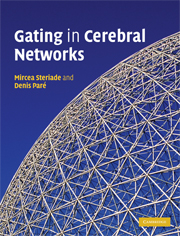Book contents
- Frontmatter
- Contents
- Preface
- Acknowledgements
- Chapter 1 Morphology and electroresponsive properties of thalamic neurons
- Chapter 2 Morphology and electroresponsive properties of neocortical cells
- Chapter 3 The amygdala
- Chapter 4 Rhinal and medial prefrontal cortices
- Chapter 5 Neuromodulation and state-dependent activities in forebrain neuronal circuits
- Chapter 6 Gating of signals in slow-wave sleep
- Chapter 7 Neuronal processes and cognitive functions in brain-active states of waking and REM sleep
- Chapter 8 Comparison of state-dependent activity patterns in the thalamocortical, hippocampal and amygdalocortical systems
- Chapter 9 Neuronal substrates of some mental disorders
- References
- Index
- Plate section
Chapter 1 - Morphology and electroresponsive properties of thalamic neurons
Published online by Cambridge University Press: 18 August 2009
- Frontmatter
- Contents
- Preface
- Acknowledgements
- Chapter 1 Morphology and electroresponsive properties of thalamic neurons
- Chapter 2 Morphology and electroresponsive properties of neocortical cells
- Chapter 3 The amygdala
- Chapter 4 Rhinal and medial prefrontal cortices
- Chapter 5 Neuromodulation and state-dependent activities in forebrain neuronal circuits
- Chapter 6 Gating of signals in slow-wave sleep
- Chapter 7 Neuronal processes and cognitive functions in brain-active states of waking and REM sleep
- Chapter 8 Comparison of state-dependent activity patterns in the thalamocortical, hippocampal and amygdalocortical systems
- Chapter 9 Neuronal substrates of some mental disorders
- References
- Index
- Plate section
Summary
To discuss gating processes in the thalamus during different normal and pathological conditions (see Chapters 6 and 7), we should first describe the types of neurons and neuronal networks as well as the modulation of intrinsic properties of thalamic neurons by synaptic activities in various behavioural states.
Nuclear systematization, morphology and immunoreactivity of thalamic cells
Thalamic nuclei can be systematized into sensorimotor (or relay), association, intralaminar, and reticular neuronal aggregates. The term relay indicates that those nuclei, among them visual lateral geniculate (LG), auditory medial geniculate (MG), and somatosensory ventroposterior (VP), transfer to cerebral cortex specific sensory signals arising in the ascending afferent pathway. This does not imply that such nuclei operate as mere relays, as if nothing would change between activities in afferent fibres and in thalamocortical axons. Indeed, the presence of local-circuit inhibitory neurons in various nuclei and the relations that thalamic relay neurons entertain with thalamic reticular (RE) inhibitory neurons, account for integrative processes in thalamic relay nuclei, mainly consisting of response selectivity higher than that recorded at prethalamic levels.
Before discussing the morphology, connections and properties of different neuronal classes in the thalamus, a brief account of the major thalamic nuclei is necessary. Figure 1.1 illustrates the nuclear groups in the cat, a species of choice for the study of many topics discussed in this monograph.
- Type
- Chapter
- Information
- Gating in Cerebral Networks , pp. 1 - 26Publisher: Cambridge University PressPrint publication year: 2007
- 1
- Cited by

